This is a post solely to show how off-model these can get.
The off-model drawings of high schoolers couldn’t be more evident than in these two yearbooks. Both of these are amateurish in drawing and knowledge as one of these books with “Disney characters” features a character who isn’t even a Disney character at all. At this time in animation, every character in animation was seen as a Disney character. Walt Disney was the only face in the industry that anyone could name. Even today, the “animation ends with Disney” thought is still around. Much of the public assumed Woody Woodpecker, Bugs Bunny, and Tom and Jerry were all Disney stars.
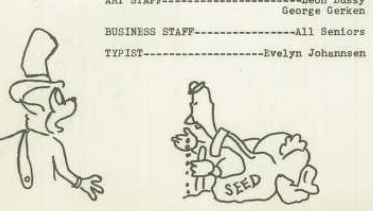
In the first yearbook, Roxbury High School put out a Disney-themed yearbook for their 1954 year. Unfortunately, some of these drawings are so off that they’re impossible to recognize. The drawing pictured on the yearbook staff page (above) is the most evident example. The character drawn looks more like Baby Huey than any Disney character (Donald’s Cousin Gus?) in my opinion. I think a few pics were swiped from the Disney comics too.
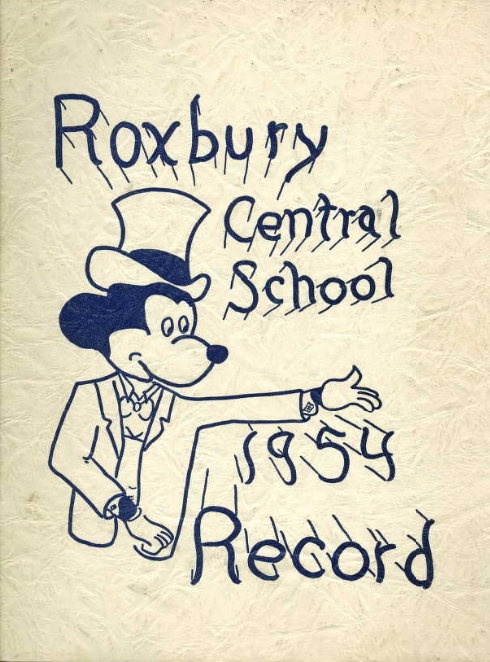
For the second yearbook, Elmer Fudd is featured as the temp-theme. However, Elmer Fudd, according to the yearbook, was borrowed from Walt Disney’s famous comic strip. I’m not sure what exactly that description comes from. However, in this edition of Atwood High School’s yearbook, Elmer is off-model (more so than probably ever before) and comes from the wrong studio and wrong medium.
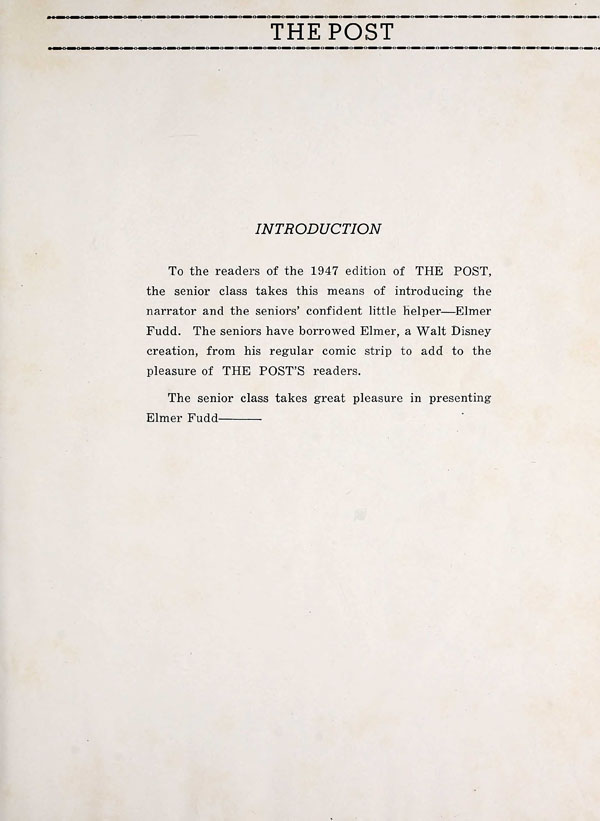
Also… I swear this is one of the last ones I’ll share that looks this awful. I have various goodies directly from Terrytoons, Lantz, and Disney to share. Also, studio granted (or so they say) uses of Disney and Warners Characters. And other good stuff.
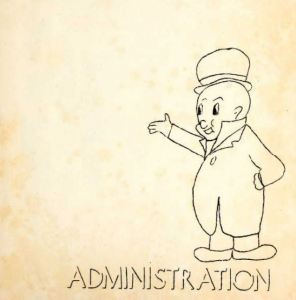
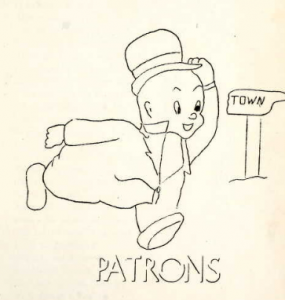
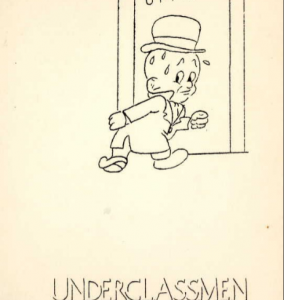
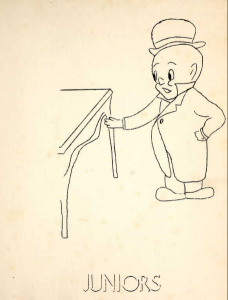
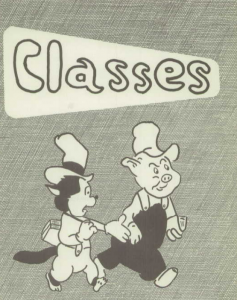
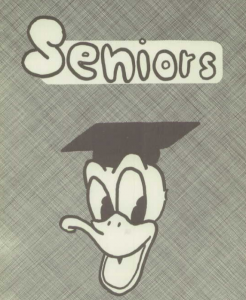
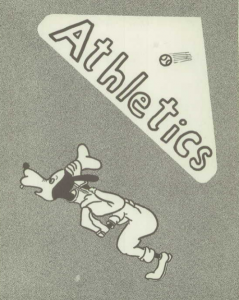
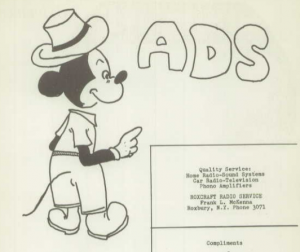
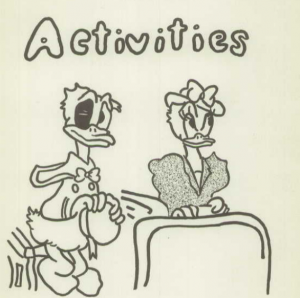
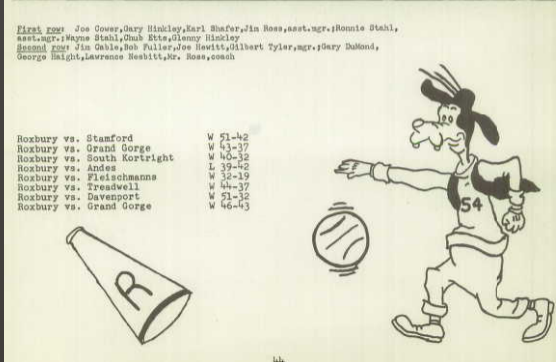


 Kamden Spies is an animation fan, collector, and aficionado. He received his undergraduate degree in an IDM in film history and creative writing from the University of Alabama at Birmingham and is currently getting his Master’s in Library and Information Sciences at Indiana University Bloomington.
Kamden Spies is an animation fan, collector, and aficionado. He received his undergraduate degree in an IDM in film history and creative writing from the University of Alabama at Birmingham and is currently getting his Master’s in Library and Information Sciences at Indiana University Bloomington.

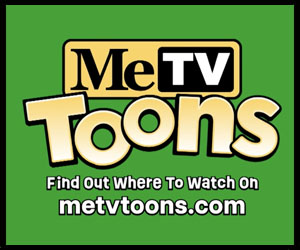
















































Roxbury Central School is in New York State, on the edge of the Catskills. There are several communities called Atwood in the U.S., and from the pages presented here I can’t determine which of them adopted Elmer Fudd as the mascot for its 1947 high school graduating class. Bad as those images are, they remind me of another school that embraced a bald-headed secondary cartoon character many years later.
A friend of mine who attended Wayne State University in Detroit in the early ’80s wrote to me about the student council election, for which several different slates of candidates were competing: the Progressive Slate, the Conservative Slate, and so on. I don’t know if it was meant to be a joke or not, but there was one group of candidates who banded together to form… the Mister Slate! Flyers promoting the Mister Slate, each featuring quite a good likeness of Fred Flintstone’s boss, were plastered all over campus. (My friend sent me one.) The Mister Slate won the election, and I have no idea what impact they had on student government.
Paul,
Thank you for all your feedback on my posts. As a young writer and college student, your opinions and contributing facts are very encouraging to me. I appreciate you commenting on all of my posts!
Thanks—
Kamden
You’re very welcome, and best wishes in all your endeavours!
Next time…I share some stills the Disney studio lended to USC during World War II. Most of these are from the Donald Duck comic strip or from Disney publicity art. Some were made directly for USC however.
I’ve never really been able to understand why “regular folks” cannot distinguish between Disney and non-Disney animation.
All the classic Disney shorts open with a sizeable “Walt Disney presents …”
Warner Bros. cartoons opened with the WB shield. MGM cartoons had Leo the lion. Fleischer and Famous cartoons had a huge mountain. UPA had a very distinctive logo which I believe was displayed quite prominently in the opening credits, etc., etc.
I’ve only seen a handful of Terrytoons on YouTube, and those are ones which I recall lack an eye-catching opening … unless the VHS-ish YouTube transfers have excised a 20th Century Fox logo from the very beginning.
I’m amazed there were people who thought Gerald McBoing Boing, Ben and Me, Red Hot Riding Hood and, um … Dinner Time, were all made by the same people. 😛
I think it comes down to the fact that most people just don’t pay any attention to film credits (and think there’s something weird about those of us who do). But if you have an interest in cartoons, or film in general, that goes beyond merely passing the time, you pretty much have to.
That off-model Elmer looks like Casper wearing Elmer’s clothes.
Kamden, the character you speculate about being Donald’s Cousin Gus is absolutely Gus—as drawn by Frank McSavage in early 1950s comic books, and then rather poorly traced.
To his left is Li’l Bad Wolf, in case there was any question.
Most of the Elmer drawings almost resembled the short-lived fat model of him that was long since abandoned by that point.
Around fifteen years ago, I was in a thrift store and noticed a ceramic Elmer Fudd figurine that had a price tag on the bottom labeled “Disney Man” by the elderly woman owner. I guess its his rounded features that cause confusion for the uninitiated. I’ve never heard of anyone mistaking Popeye or Mister Magoo for Disney properties.
Yeah, well I hope you can wrap up this series quickly, the fact that bad copies of popular characters exist is not surprising or very interesting. Might be fun to do a quick survey of instances of logos or mascots lifted over the years from Preston Blair’s book, I used to spot those all over, but again, keep it brief.
I’m sorry that you are not enjoying these posts but this series has a ways to go yet. This is the last post of the truly off-model stuff though. That part of these posts is now over. Most of what’s left is either original or licensed. Terrytoons, Disney, and Warners all drew and designed yearbooks. Also, Felix the Cat has been a high school for over 100 years and that school has been very gracious with helping me explore the history of Felix’s mascot days.
Any Disney or Warner Bros. cartoon reference from the 1940’s through the mid-1970’s are most likely going to be from Dell or Gold Key comic books. In 1954, the comic book versions of these characters were probably seen more than the actual animated cartoons themselves. Dell used to print millions of these comics every month. It was more likely that you would see Donald Duck in a comic book than you would see one of his cartoons at the movies. And the cartoons weren’t shown on television.
As for people not knowing which studio produced which characters, there really wasn’t any reason for the public to know. They probably didn’t know which actors were contracted to which studios either. The public was just goin’ to the show. If they didn’t care which studio produced the feature, they weren’t going to wonder about which studio produced the cartoons.